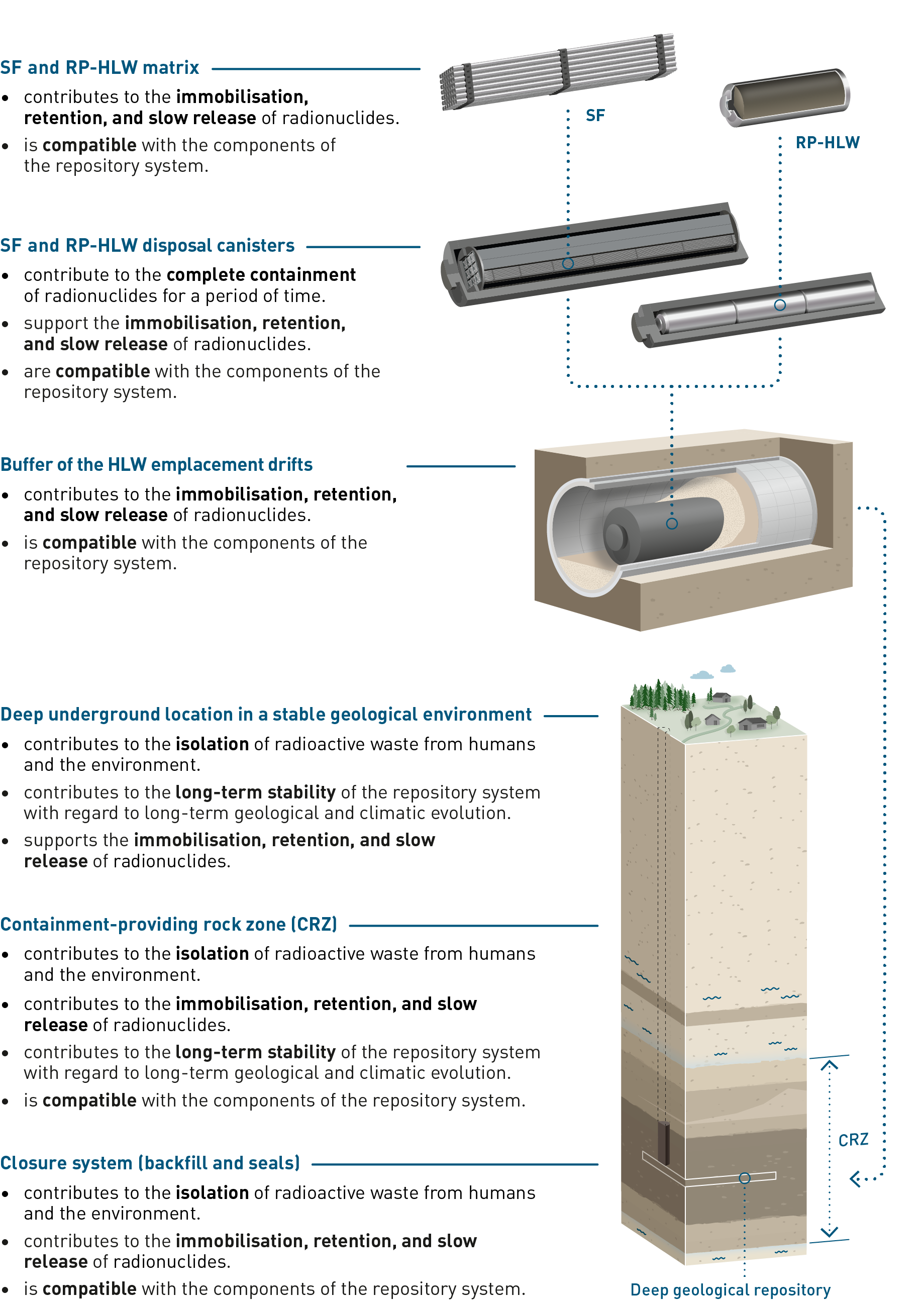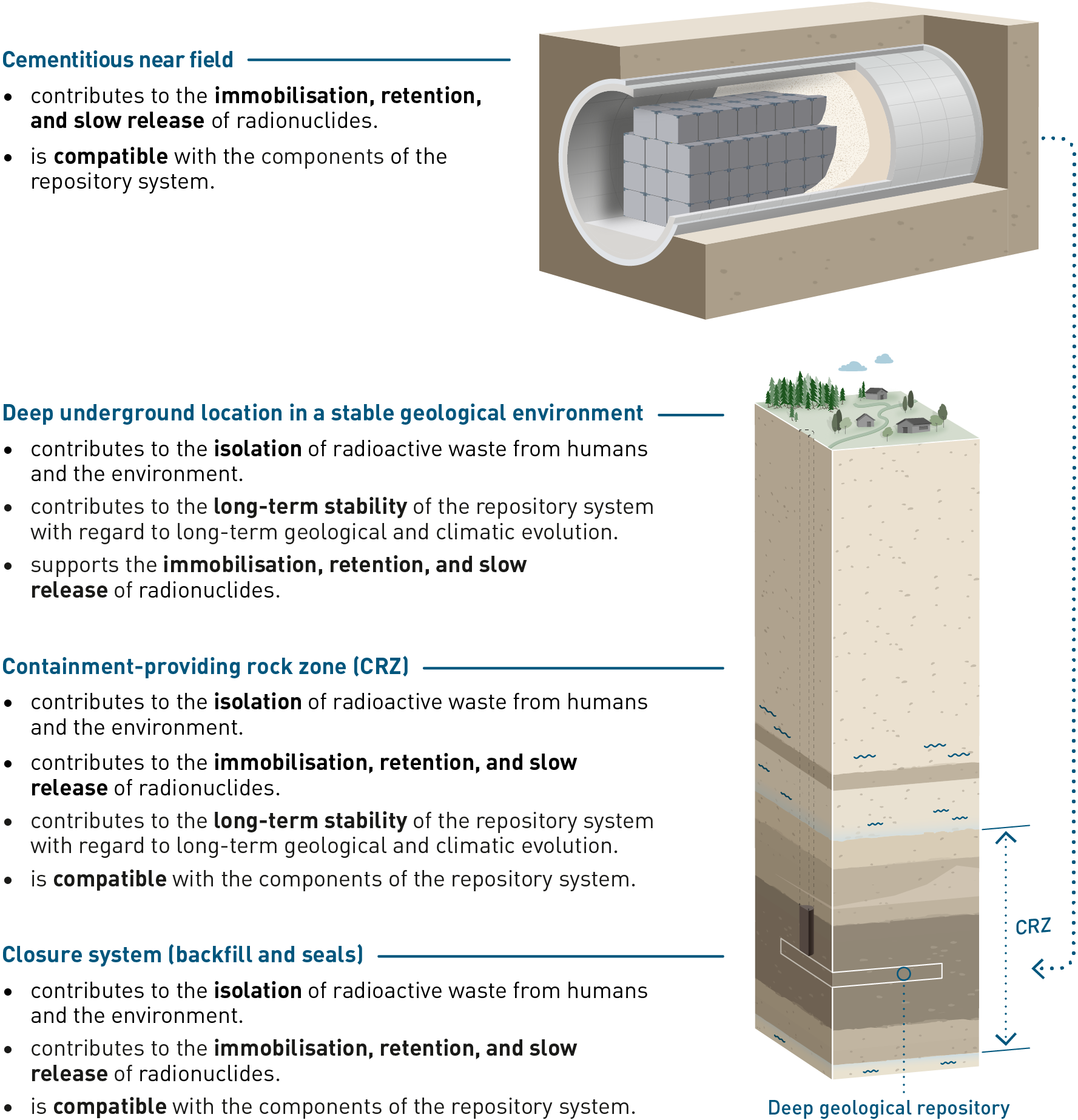The repository barriers and their properties that are the main contributors to these safety functions are termed “pillars of safety”. They are well understood and insensitive to perturbations. The seven pillars of safety are:
-
The deep underground location of the waste emplacement rooms in a stable geological environment that lacks underground resources specific to the region that could attract future human exploitation. It ensures that the repository is not susceptible to geological events and processes relevant to post-closure safety and that inadvertent human intrusion remains unlikely.
-
The containment-providing rock zone (CRZ) includes the host rock as well as upper and lower confining geological units. The host rock, Opalinus Clay, is characterised by a fine and homogeneous pore structure, extremely low hydraulic permeability, a homogeneous and high clay-mineral content and the associated high sorption capacity for many radionuclides. The CRZ is characterised by favourable properties (especially self-sealing ability) for long-term stability, forming a very effective and stable barrier against radionuclide transport and a compatible (physical and chemical) environment for the engineered barriers (NAB 24-18 Rev. 1, Nagra 2024s).
-
Both the SF and RP-HLW matrices are chemically stable in the expected environment.
-
The SF and RP-HLW disposal canisters are mechanically stable and corrosion-resistant in the expected environment. They ensure complete containment of radionuclides for at least as long as the heat generated by the waste has significant potential to affect transport processes in the surrounding barriers. They satisfy the regulatory requirement of complete containment for at least 1,000 years (ENSI 2023).
-
The HLW emplacement drifts will be backfilled with a buffer. This buffer serves as a suitable physical and chemical environment that enhances the longevity of the HLW disposal canisters. Additionally, the buffer offers structural support to the surrounding rock after the degradation of the tunnel support. It compartmentalises the repository by isolating the disposal canisters from one another, thereby mitigating the impact of accidental human intrusion. The buffer reduces the potential effects of heat release on the safety relevant properties of the CRZ and acts as a barrier against radionuclide transport.
-
The L/ILW cementitious near field promotes sorption of radionuclides, decreases corrosion of metals and inhibits degradation of organic materials, which in turn reduces gas generation. The cement-based backfill can also store a significant volume of gas and provides mechanical stability to the host rock, even after the degradation of the tunnel support.
-
The closure system (backfill and seals) provides retention of radionuclides released from the waste packages, and a transport and storage system for repository-generated gas, which retains gaseous radionuclide species within the underground structures while limiting the build-up of gas pressure. The sealing of both the individual waste emplacement rooms and the HLW and L/ILW repository sections reduces safety-relevant interaction between the repository sections and the radiological impact of inadvertent human intrusion. The closure system further provides mechanical stabilisation of the host rock after the rock support has degraded.
Each pillar of safety can contribute directly and/or indirectly to the safety functions. For example, the HLW disposal canisters contribute directly to the containment of radionuclides, while the surrounding buffer contributes indirectly as it helps to protect the canisters. Compatibility between the different pillars of safety is based upon a solid technical and scientific understanding of the geological and engineered components (see Chapter 5).
The contributions of these seven pillars of safety to the five safety functions are summarised schematically in Fig. 3‑3 and Fig. 3‑4 and are elaborated in the discussion of component-specific functions in Section 3.4 of NAB 24-18 Rev. 1 (Nagra 2024s).

Fig. 3‑3:Summary of the functions of the pillars of safety for HLW disposal in the current repository concept

Fig. 3‑4:Summary of the functions of the pillars of safety for L/ILW disposal in the current repository concept

